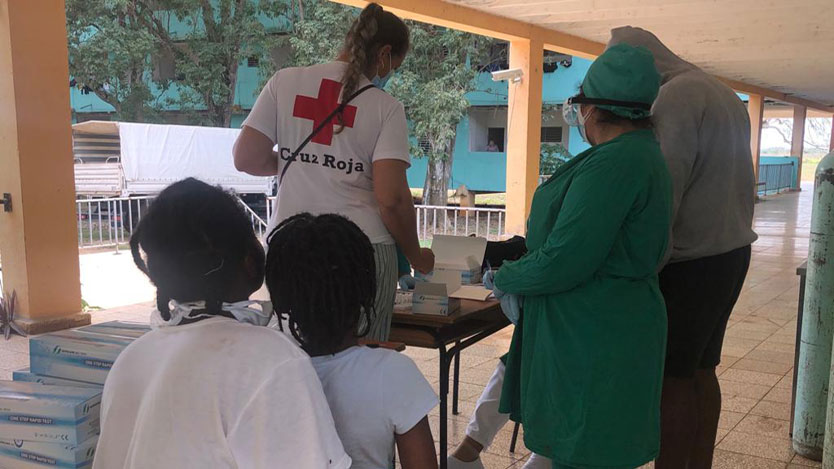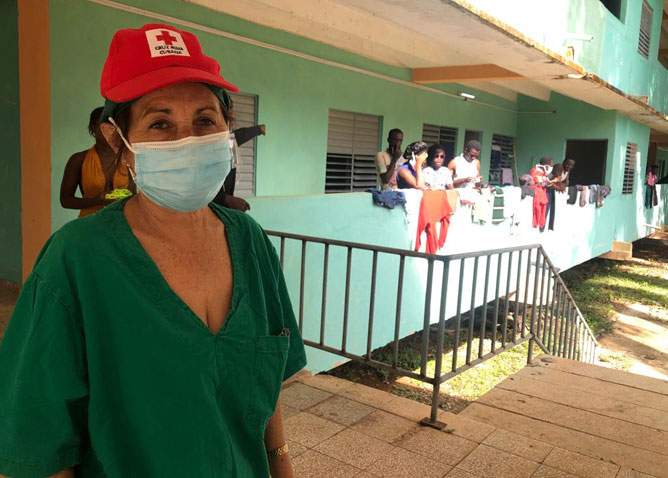
The Passage of the Winds pushed 292 Haitians to the west who were looking for the north. It was very difficult for them to find him. Moreover, it is very easy to predict the arrival of a boat packed with emigrants who plunged into a strait of barely 80 kilometers, swirled by strong sea currents.
That is the shortest distance between Cuba and Haiti, but it was not the one they traveled. For five days they were in the water and even without believing they were shipwrecked, they must have sailed some 400 miles, until they ended up landing on the Ciego de Ávila coast, in need of water and food.
From Cayo Paredón, they would be transferred to Puerto Casasa, in Cayo Coco, and from there to Ceballos 8, where they arrived at 2:00 a.m. on February 9. Five hours before, the volunteers of the Ciego de Ávila`s Red Cross were already there.
The lifeguards Bárbara Rodríguez and César Moreno would make up a larger team that came to prepare rooms, make beds, distribute toilets, and sweep the place… Ceballos 8, which had served as a care center during COVID-19, was once again an old school, way to become 73 dwellings. It was not ready for 292 Haitians, or Cubans.
Hence, the constructive forces of the territory finalized the details that time allowed them, while the couple of volunteers, united at home and office, relived the situation of October, four months ago, when a group of 50 Haitians also landed in the Ciego de Ávila coast and they assisted them, then in Ceballos 7.
That stack of days was actually 25. The Secretary General of the Red Cross in Ciego de Ávila, Ileana Fuentes Torres, accompanied them on the plane back. On October 9, he landed in Port-au-Prince. Exactly four months and Peterson Lyam, who was also on that flight, returns to Cuba. It is his second attempt and Ciego de Ávila his “second lifeline”, after days on a ship, whose nightly images, even from a low-performance cell phone, reveal the suicide. The mast has the appearance of not being able even with the sail. How much longer could he have with 292 Haitians?
The straightest line between Haiti and Florida exceeds 700 miles; however, Peterson knows that you do not travel in a straight line and it is not that simple. After his second attempt, he does not deny that there will be a third nor does he affirm it, either. It only says that "Haiti is bad" and that "the sea is also bad." He also says that he does not want to leave Cuba, that here he could study and become a doctor.

Ileana Fuentes Torres, general secretary of the Red Cross in Ciego de Ávila, takes a short break from the hustle and bustle
What he does seem to be very clear about is that he does not want to stay in Haiti, which as long as the ancestral cycle of poverty and violence continues there, intensified in the middle of the year, after the assassination of President Juvenel Moise, other attempts "will come to the fore."
"Everything is very sad," he says with reddened eyes, reluctant to take photos. No immigrant agrees to tell his or her story; too soon, to recreate the trauma, I guess.
For this reason, once the sampling to detect malaria and COVID is completed, their data will be located and through two enabled telephones, they will be able to communicate with their loved ones.
“The Red Cross Restoring Family Links (RCF) service is one of the first types of assistance we provide,” says Ileana Fuentes. They are usually two minutes, enough time to give signs of life and count the conditions in which they are found.
Ania Rosa Francisco Malde, deputy governor of the province, outlines them for Invasor. He clarifies that although they must continue to prepare the place, “there they are offered breakfast, lunch, dinner and snacks. They have toilets, sheets, towels, water, medical services and other actions are coordinated to guarantee well-being.” A small brigade, for example, prepared seven more rooms to relieve the concentration of somewhere they spent the night and where they will have to stay for several days.
It is still too early to define how many. The general secretary of the Red Cross does not dare to predict them. Security is precisely that they will return safely.
A Granma report offered the data in the voice of Roel Estévez Matos, administrator of the refugee camp in Guantánamo: from 2001 to October 2021, 76 Haitian boats had landed on those shores, bringing on board more than 4,000 immigrants.
The one that arrived in Ciego de Ávila, with 292, adds to that avalanche.
